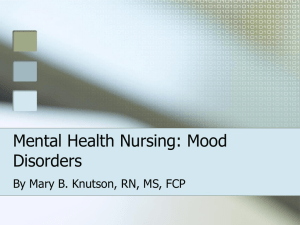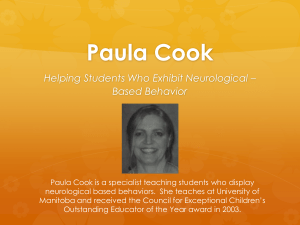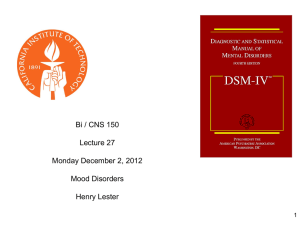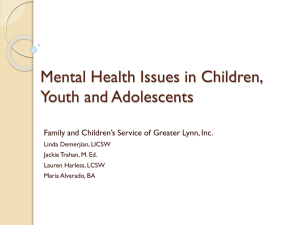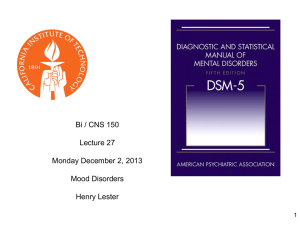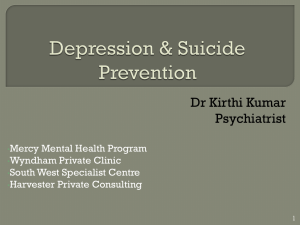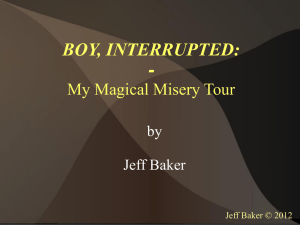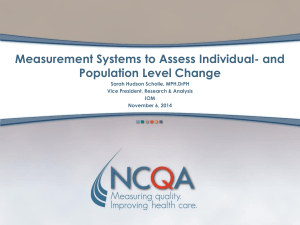Mood Disorders in Children and Adolescents
advertisement
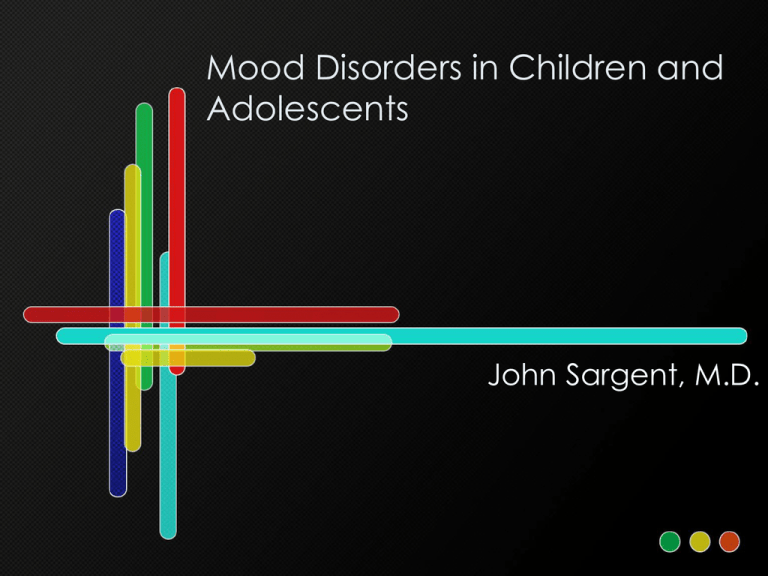
Mood Disorders in Children and Adolescents John Sargent, M.D. • Learning Objectives: • 1) Learn about the signs, symptoms and prevalence of depression and bipolar disorder in children and adolescents. • 2) Learn about integrated care for youth with mood disorders. Depression affects 3% of children and 6 – 8% of adolescents 2 of 3 depressed teens are girls Depression represents a gene – environment interaction • Family and contextual risk factors influence the occurrence • Individual cognitive distortions, global and personal attribution styles and pessimism also increase its likelihood • Family risk factors include – Parental depression – Family stressors such as moving, job loss, homelessness and poverty – Persistent marital or post divorce conflict – Persistent parent – child conflict or distrust • Other factors inciting or exacerbating depression include – Parental loss – Chronic conflict with a step parent or paramour – Family suicidality or family history of completed suicide • Symptoms of Depression in Children and Adolescents – – – – Poor concentration Irritability Experience of boredom Quitting or decreased involvement in activities or relationships • Further symptoms develop as depression persists – – – – Poor school performance Social isolation Family conflict Appetite and sleep changes – Appetite disorders – substance abuse, eating disorder, cutting among adolescents – Hopelessness – Acute and chronic suicidal ideation – Suicide attempts Depression associated with… • Child neglect • Parental depression or substance abuse • Significant childhood difference (handicap, illness, learning disability) • Domestic violence, marital conflict or persistent post separation parental conflict • Other forms of child abuse Depression is often co-morbid with other problems • Substance Abuse in Adolescents • Anxiety and Post Traumatic Stress Disorder • Unresolved grief • ADHD • School failure/learning disability • Conduct problems • Specific risk factors for suicide in depressed teens – Obesity – Teasing and bullying – Previous suicide attempts – History of childhood maltreatment – Access to firearms – Fluctuations in developmental maturity – Concerns about sexual orientation – Drug or alcohol intoxication – Rejection, shaming failure or argument with important person (attachment figure) – Impulsivity • During the interview the examiner will often note that he/she feels sad while talking with the child History should always include… • Family status • Family stresses and transitions (moving, divorce, death of family member, economic distress/loss of job) • History of abuse – physical, sexual, emotional • Peer Relationships • Legal difficulties and sexual activity (for children over age 11) • Substance use/abuse • School performance • Previous Psychiatric treatment • Family history of psychiatric disorder • Suicidal ideation, intent, attempts Severity is indicated by… • Presence of suicidality • Child’s ability to respond to warmth of interviewer • Child’s ability to identify strengths and enjoyable experiences • The interviewer’s experience of hopelessness and helplessness • Treatment Approaches – Identify suicidality and develop a plan to limit suicidal behavior – Build connections and competence – Involve family in treatment and address family problems especially parental depression – Identify problems caused by depression and develop methods of separating depression from the person – Limit substance abuse, treat co-morbid problems and encourage academic success and pro social behaviors and peer relationships – Use psychopharmacology when needed to facilitate treatment – Assist patient and family in deciding on and monitoring psychopharmacology – Monitor for switching to mania and for increased suicidal impulses It is essential to monitor and support return to normal development in school, with peers and in family during treatment Remember 10% of depressed children and adolescents will progress to develop Bipolar Disorder, often these teens have strong family history of Bipolar Disorder Be wary of suicidal behavior during treatment, especially at points of conflict and perceived isolation Build on unique skills, strengths and talents of both the child and his/her family Prepare family and adolescent for the possibility of relapse including identifying early signs warranting return to treatment Be aware of the influence of a culture of violence upon child or adolescent behavior Bipolar Disorder Alternating periods of depression and mania. Occurs in approximately 0.51% of population Mania • Distinct period of time where child manifests symptoms of mania – Grandiosity, expansive mood – Pressured speech, flight of ideas – Decreased need for sleep – Engaging in potentially dangerous, risky behaviors, sexual promiscuity, excessive spending, engaging in dubious or risky projects (Impulsivity) – Enhanced sense of well-being/perceived productivity – May include irritability, law breaking, substance abuse, teen pregnancy/paternity and aggressiveness. These symptoms more likely in children with a history of maltreatment. Children are more likely to have rapid (hourly to daily) changes in mood. Older adolescents more likely to have classical (adult) mania Impulsivity, consequences of risky behavior, intoxication, incarceration and isolation are precursors of suicidal behavior in bipolar youth Treatment of bipolar disorders in children and adolescents often extremely challenging Family involvement and family stability are essential in effective treatment. Pay attention to the role of poverty, limited access to care and family chaos for child and family Family psychoeducation/decreasing family expressed emotion is extremely helpful Suicide prevention plan always part of treatment. This includes attention to firearms, planning for impulsivity and rejecting and shaming experiences Psychopharmacology may include mood stabilizers, atypical antipsychotics and often both. Attention to side effects is essential Bipolar Disorder Treatment • Antimanic psychopharmacology – Depakote or Lithuim – Atypical antipsychotics • Abilify • Risperdal – 2 drug treatments – Limited effectiveness of anticonvulsant drugs • Trileptal • Topomax • Lamictal • Neurontin Co morbid ADHD, academic and legal problems may complicate situation and must be addressed Building self – awareness, self assessment and self management are important Parenting Support • Parental consistency • Reducing negative expressed emotion • DBSA – parental support • Consistent longitudinal care/crisis plan Frequently family psychosocial circumstances complicate treatment and outcome (due to poverty, parental difficulties, single parenthood, lack of insurance and limited access to care) In some instances BPD may be comorbid with ADHD. In these cases treat BPD first, and then add ADHD treatment • In some instances what looks like ADHD evolves into frank BPD. Families often find this diagnostic drift confusing These cases are always challenging and always require multidimensional, integrated treatment Course may be chronic with intermittent exacerbations and recurrent suicidality Development of long term treating relationships and long range treatment plan can be very helpful Remember not every child or adolescent who has emotional and behavioral dysregulation has Bipolar Disorder • There is a group of children who present significant problems especially with affect regulation difficulties, impulse control problems, aggressiveness and poor response to frustration Some are experiencing sequellae of abuse and some have incipient personality disorders These children’s problems often include explosiveness, a lack of self – control that often requires police involvement and/or psychiatric hospitalization These children’s difficulties also often involve juvenile justice, multiple hospitalizations, school failure, expulsions and alternative school placement and polypharmacy • Outbursts usually occur following frustration, perceived slights or disrespect, often within a context of emotional invalidation and disregard These patients require treatment of these problems in addition to psychopharmacology to limit arousal and manage periods of low mood A wide range of initial difficulties may lead to this clinical picture • Previous significant abuse or maltreatment (may include domestic violence) • CPS placement, placement transitions • Mental retardation or significant brain injury • Parental inconsistency • Substance Abuse • Marked Attachment Problems This is complicated by… • Diagnostic confusion • Lack of continuity of care • Multiple placements • Reinforcement of aggressive/explosive behavior • Lack of effective family involvement • Therapeutic inconsistency Defining Features • Absence of expansive mood and decreased need for sleep • Episodes are related to frustration, failure and/or criticism • Episodes are generally discrete and goal directed, frequently viewed as defensive reactions A variety of diagnosis may be appropriate including • PTSD • Complex PTSD • ODD • Conduct Disorder • Depression • ADHD Common features of the children include • Poor affect regulation • Poor impulse control • Poor attachment experiences • Limited consideration of consequences of behavior • Overall irritable mood Important considerations • Role of negative coercive interactions • Limited involvement in satisfying activities and prosocial peer groups Treatment Approaches • Limit arousal (psychopharmacology) • Improve mood or decrease anxiety with SSRI’s (if warranted) • Promote attachment • Develop a crisis plan • Decrease negative expressed emotion • Promote satisfying activities and relationships • Chart episodes of high arousal, aggressiveness • Enhance family relationships/functioning • Teach tolerance for frustration • Observe and alter provocation patterns • Teach self – soothing and build social support
